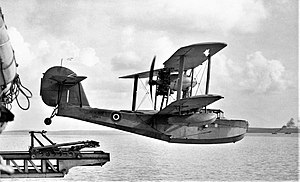
Back Supermarine Walrus Afrikaans Supermarine Walrus Czech Supermarine Walrus German Supermarine Walrus Spanish Supermarine Walrus Finnish Supermarine Walrus French Supermarine Walrus Hungarian Supermarine Walrus Italian スーパーマリン ウォーラス Japanese Supermarine Walrus Dutch
| Walrus | |
|---|---|

| |
| A 1943 photograph of a Walrus being launched from HMS Bermuda, a Fiji-class light cruiser | |
| Role | Amphibious maritime patrol aircraft |
| National origin | United Kingdom |
| Manufacturer | Supermarine |
| Designer | R. J. Mitchell |
| First flight | 21 June 1933 |
| Introduction | 1935 |
| Primary users | Royal Navy Irish Air Corps Royal Air Force Royal Australian Air Force |
| Produced | 1936–1944 |
| Number built | 740 |
| Developed from | Supermarine Seagull III |
The Supermarine Walrus (or the Supermarine Seagull V, its original name) is a British single-engine amphibious biplane designed by Supermarine's R. J. Mitchell at their works at Woolston, Southampton. Primarily used as a maritime patrol aircraft, it was the first British squadron-service aircraft to incorporate an undercarriage that was fully retractable, crew accommodation that was enclosed, and a fuselage completely made of metal.[1]
The Walrus first flew in 1933, the design process having started as a private venture four years earlier. It shared its general arrangement with that of the earlier Supermarine Seagull. Having been designed to serve as a fleet spotter launched by catapult from cruisers or battleships, the aircraft was employed as a maritime patrol aircraft. Early aircraft featured the original metal hull design for its greater longevity in tropical conditions, while the later variant, the Supermarine Walrus II, instead used a wooden hull to conserve the use of light alloys.
The Supermarine Seagull V entered service with the Royal Australian Air Force in 1935. The type was subsequently adopted by the Fleet Air Arm, the Royal Air Force (RAF), the Royal New Zealand Navy, and the Royal New Zealand Air Force. Walruses operated against submarines throughout the Second World War, and were also adopted by the RAF Search and Rescue Force to recover personnel from the sea. It was intended for the Walrus to be replaced by the more powerful Supermarine Sea Otter, but this was not implemented. Following the end of the war, the Walrus continued to serve as a military aircraft, and some aircraft operated in a civil capacity in regions such as Australia and the Antarctic. The Walrus was succeeded in its air-sea rescue role by the first generation of helicopters.
- ^ Brown 1971, p. 28.
© MMXXIII Rich X Search. We shall prevail. All rights reserved. Rich X Search